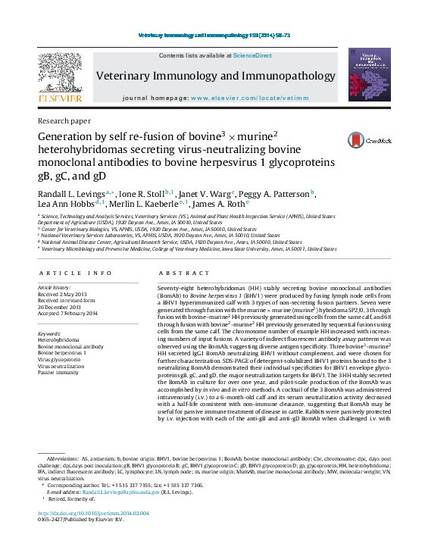
Article
Generation by Self Re-Fusion of Bovine3 × Murine2 Heterohybridomas Secreting Virus-Neutralizing Bovine Monoclonal Antibodies to Bovine Herpesvirus 1 Glycoproteins gB, gC, and gD
Veterinary Immunology and Immunopathology
Document Type
Article
Disciplines
Publication Version
Published Version
Publication Date
5-1-2014
DOI
10.1016/j.vetimm.2014.02.004
Abstract
Seventy-eight heterohybridomas (HH) stably secreting bovine monoclonal antibodies (BomAb) to Bovine herpesvirus 1 (BHV1) were produced by fusing lymph node cells from a BHV1 hyperimmunized calf with 3 types of non-secreting fusion partners. Seven were generated through fusion with the murine × murine (murine2) hybridoma SP2/0, 3 through fusion with bovine–murine2 HH previously generated using cells from the same calf, and 68 through fusion with bovine2-murine2 HH previously generated by sequential fusions using cells from the same calf. The chromosome number of example HH increased with increasing numbers of input fusions. A variety of indirect fluorescent antibody assay patterns was observed using the BomAb, suggesting diverse antigen specificity. Three bovine3–murine2 HH secreted IgG1 BomAb neutralizing BHV1 without complement, and were chosen for further characterization. SDS-PAGE of detergent-solubilized BHV1 proteins bound to the 3 neutralizing BomAb demonstrated their individual specificities for BHV1 envelope glycoproteins gB, gC, and gD, the major neutralization targets for BHV1. The 3 HH stably secreted the BomAb in culture for over one year, and pilot-scale production of the BomAb was accomplished by in vivo and in vitro methods. A cocktail of the 3 BomAb was administered intravenously (i.v.) to a 6-month-old calf and its serum neutralization activity decreased with a half-life consistent with non-immune clearance, suggesting that BomAb may be useful for passive immune treatment of disease in cattle. Rabbits were passively protected by i.v. injection with each of the anti-gB and anti-gD BomAb when challenged i.v. with BHV1 24 h later. Self re-fusion was shown to be advantageous for efficiently producing HH stably secreting host monoclonal antibodies. The BomAb described should prove useful in studies of the host immune response to BHV1, as reagents, and as sources of bovine immunoglobulin sequences.
Rights
Works produced by employees of the U.S. Government as part of their official duties are not copyrighted within the U.S. The content of this document is not copyrighted.
Language
en
File Format
application/pdf
Citation Information
Randall L. Levings, Ione R. Stoll, Janet V. Warg, Peggy A. Patterson, et al.. "Generation by Self Re-Fusion of Bovine3 × Murine2 Heterohybridomas Secreting Virus-Neutralizing Bovine Monoclonal Antibodies to Bovine Herpesvirus 1 Glycoproteins gB, gC, and gD" Veterinary Immunology and Immunopathology Vol. 159 Iss. 1-2 (2014) p. 58 - 73 Available at: http://works.bepress.com/james_roth/46/

This article is from Veterinary Immunology and Immunopathology 159 (2014): 58, doi:10.1016/j.vetimm.2014.02.004.